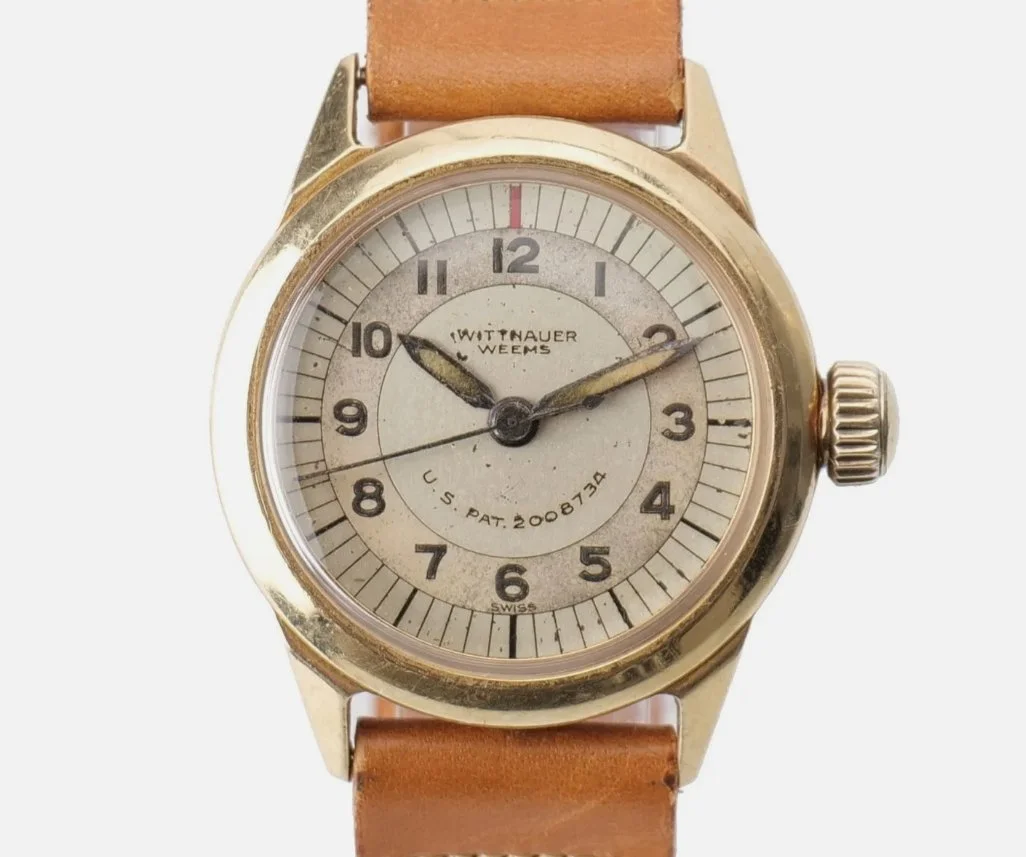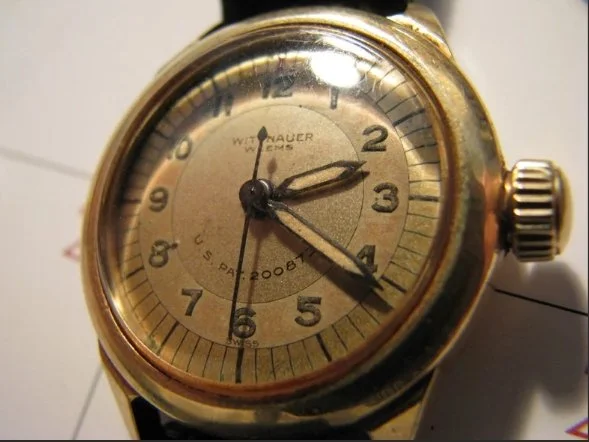Wittnauer Weems 14k
The 14k gold versions of the Wittnauer Weems are quite rare compared to their stainless steel counterparts. Most Wittnauer Weems watches were produced in stainless steel due to their intended use in aviation and military settings, where durability and resistance to corrosion were more critical than aesthetics.
A 14k gold Wittnauer Weems watch would have been a special or limited production model, likely intended for a more affluent clientele or for ceremonial purposes rather than for practical navigation. The rarity of these watches in gold can make them highly desirable among collectors, especially if they are in good condition and retain original parts.
14k gold Wittnauer Weems are seen without the rotating bezels, cased in a 14k gold screwback case with dust cover protecting the movement. Here are some examples of this watch that have surfaced throughout the years.
Examples that have surfaced over the years
The History of the Wittnauer Weems Watch
The Wittnauer Weems watch, also known as the Wittnauer Weems Navigation Watch, is a significant piece in the history of horology and aviation. This watch, which was designed to aid navigators and aviators, is renowned for its precision and unique design features that cater specifically to the needs of early 20th-century pilots.
Origins and Invention
The Wittnauer Weems watch is named after its inventor, Lieutenant Commander Philip Van Horn Weems of the United States Navy. Commander Weems was a pioneering aviator and an esteemed navigation expert who, in the late 1920s and early 1930s, developed several tools and techniques to improve the accuracy of celestial navigation. He realized that in order to navigate accurately while flying, pilots needed a watch that could be synchronized easily and precisely with a radio time signal.
The "Weems System of Navigation" introduced a rotating bezel, which allowed the wearer to quickly and easily adjust the second hand to synchronize the watch with the radio time signal. This feature was crucial in an era when accurate timekeeping was essential for navigation, as it enabled pilots and navigators to maintain their bearings over long distances.
The Collaboration with Wittnauer
In 1932, Weems collaborated with the A. Wittnauer Company, an American watchmaker known for producing precision instruments and chronometers, to create a commercially available version of his navigation watch. Wittnauer was a perfect partner for Weems, as the company had a strong reputation for producing high-quality timepieces and had already supplied various aviation and military watches.
The Wittnauer Weems watch featured a large, clear dial with easily readable numerals, a rotating bezel to adjust for seconds, and a prominent crown that allowed for easy adjustment, even when wearing gloves. These design elements made the watch highly functional for pilots who needed to read the time at a glance and adjust the watch without any delay.
Features and Design
The Wittnauer Weems watch became known for its robust construction and the unique rotating bezel. This bezel was not only a novelty but a necessary feature for synchronization with the radio time signals. The watch also had a distinctive 24-hour subdial, which allowed pilots to track time in a 24-hour format, which was more intuitive during long flights across multiple time zones.
One of the hallmark designs of the Weems watch was its large size, which was relatively unusual for the era. This size was not just for aesthetic purposes but also to enhance readability, a crucial feature for pilots and navigators who often had to check the time in difficult conditions or under stress.
Military and Civilian Use
The Wittnauer Weems was used extensively during the 1930s and 1940s by both military and civilian aviators. Its precision and reliability made it a favorite among pilots who flew the early air routes and conducted long-distance flights. During World War II, the watch was adopted by various Allied air forces, adding to its reputation as a reliable tool for aviators.
After the war, the watch continued to be popular, especially among aviation enthusiasts and collectors who appreciated its historical significance and unique functionality. The Wittnauer Weems is often regarded as one of the quintessential navigation watches of its time, alongside other famous models like the Longines Lindbergh.
Legacy and Influence
Today, the Wittnauer Weems watch is highly regarded by collectors and watch enthusiasts. Its historical importance as a tool for navigation and its innovative features make it a significant piece of horological history. The principles behind its design continue to influence the design of modern pilot watches, demonstrating the enduring impact of Weems' innovations.
In conclusion, the Wittnauer Weems watch is more than just a timepiece; it is a symbol of the pioneering spirit of early aviation and the advancements in navigation technology during a critical period in history. Its blend of functionality, innovation, and design has left a lasting legacy in the world of horology.






